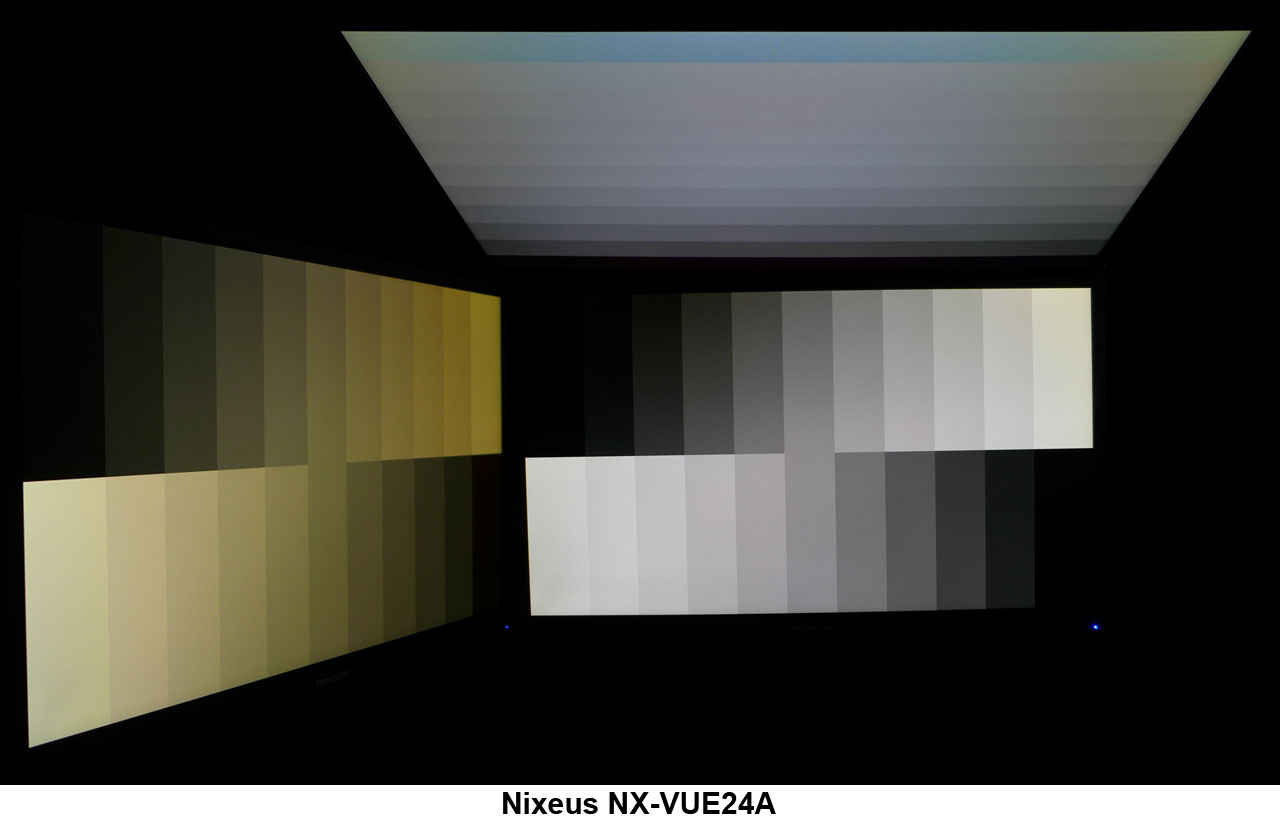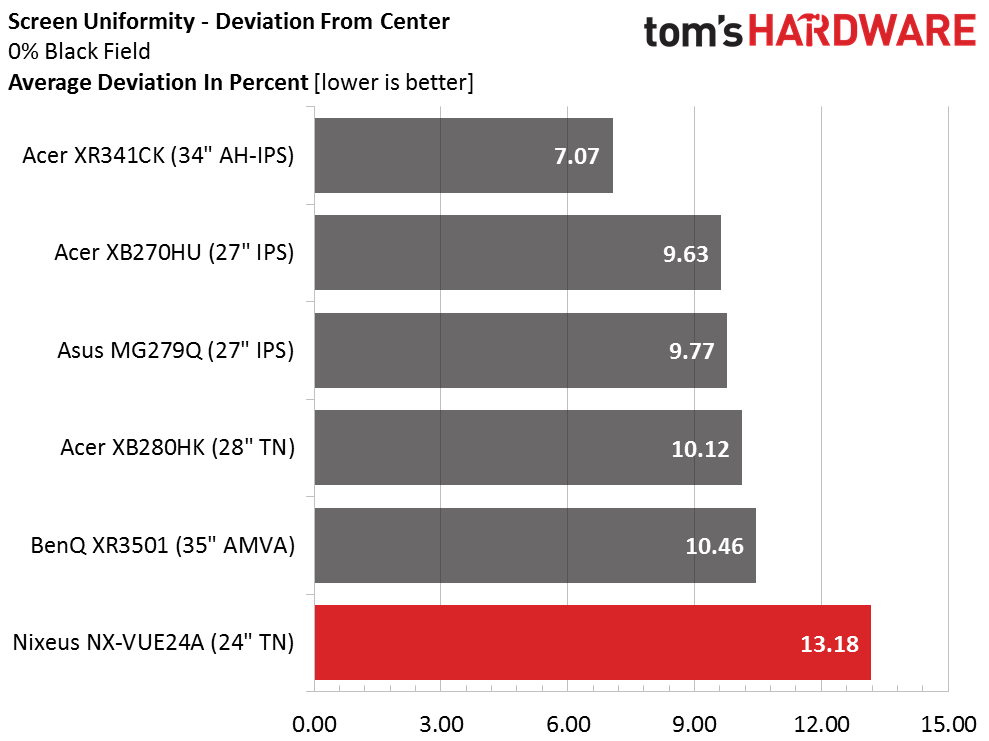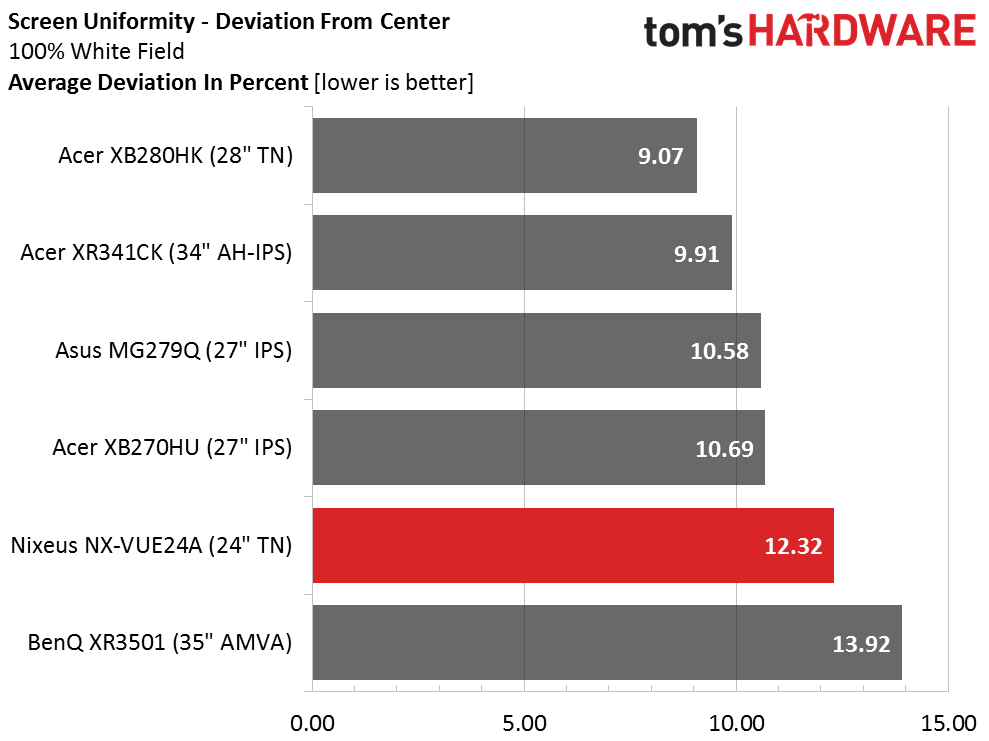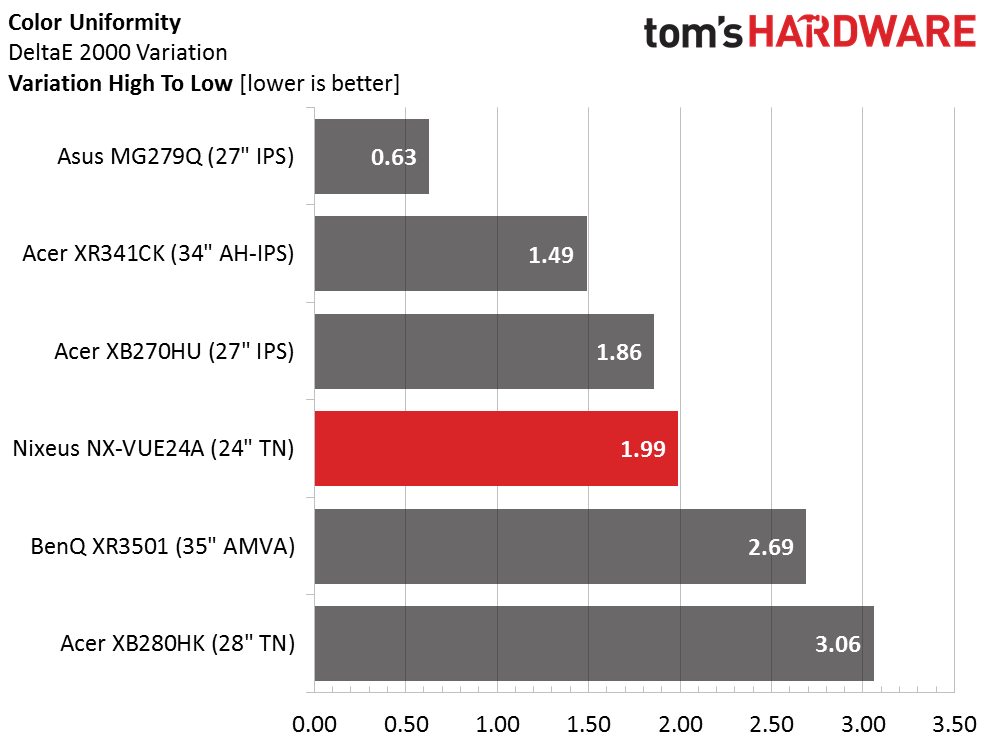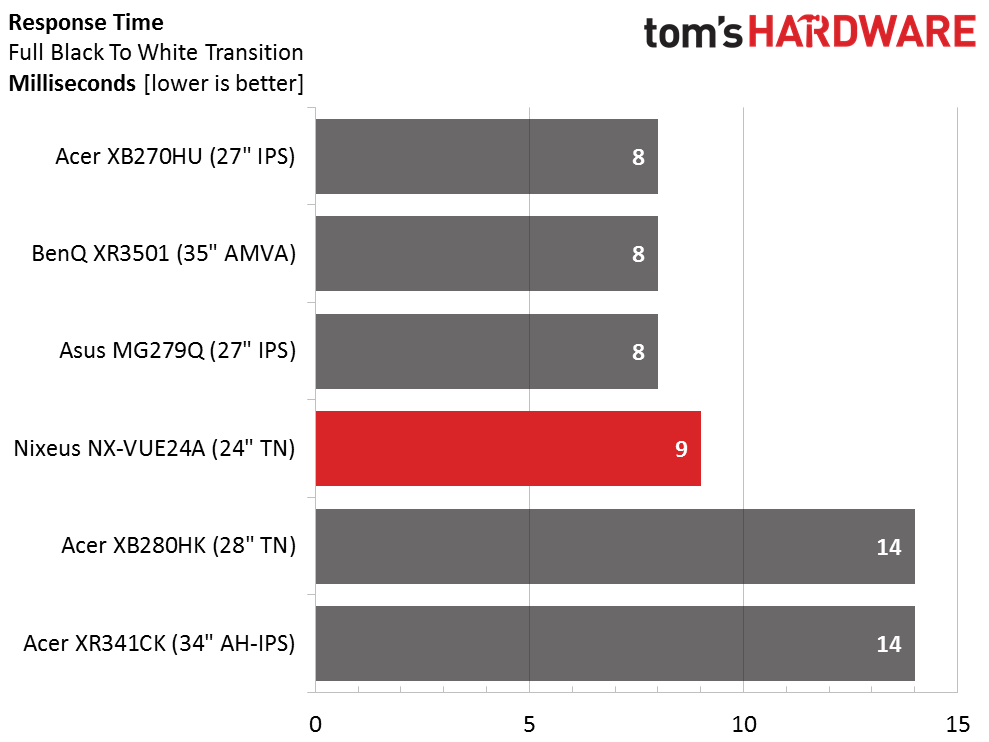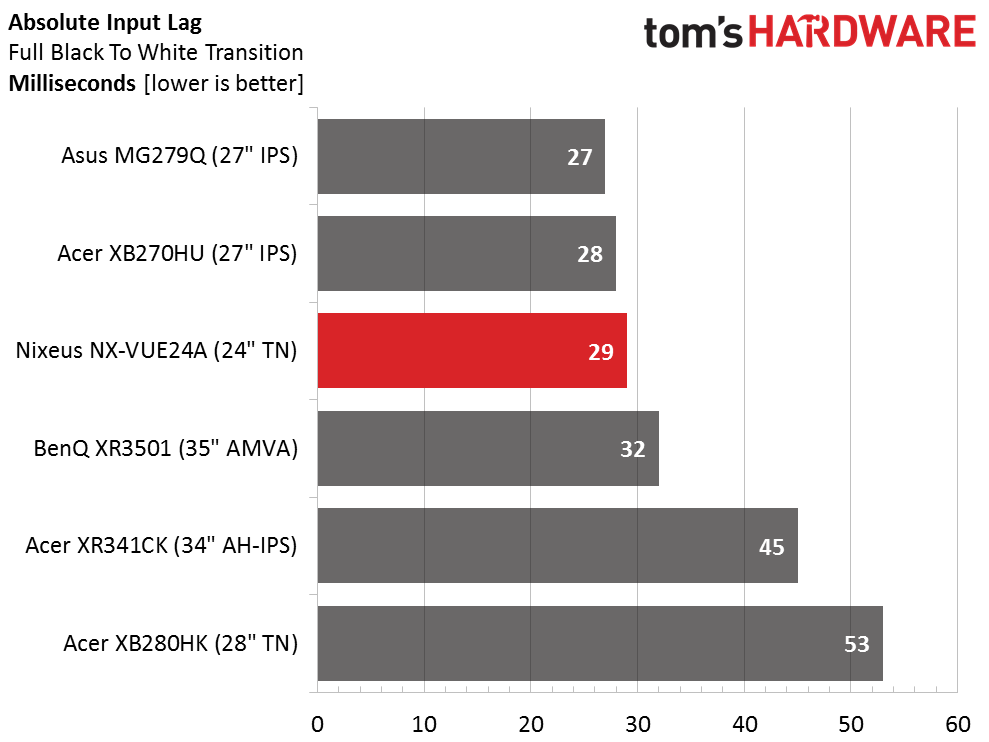Nixeus NX-VUE24A Monitor Review
FreeSync and G-Sync monitors are selling at a premium but Nixeus breaks that trend with a value-priced 24-inch model the runs FreeSync from 30 to 144Hz. Today we check out the NX-VUE24A.
Why you can trust Tom's Hardware
Viewing Angles, Uniformity, Response, Lag And FreeSync
To learn how we measure screen uniformity, please click here.
The NX-VUE24A’s TN panel is one of the main reasons for its low price. We know this technology is weak in the viewing angle department. Like nearly every similar display we’ve photographed, there is significant light falloff and a red shift to the sides. When viewing from the top, detail is nearly obliterated and you can clearly see a blue tint. From head-on and at a typical seating distance of 24-36 inches, the screen looks uniform with no detail crush or color shifts present. We look forward to the day when all monitors are IPS or VA and cost as little as this one.
Screen Uniformity: Luminance
Our sample screen actually looks better than the test result indicates. The high number is solely due to a center hotspot. The surrounding zones are very close to one another with no visible light bleed or blotching. The center zone is only noticeable when all the room lights are turned off.
Here’s the white field measurement.
The center zone affects the white field test in the same way. All surrounding areas are just a tad dimmer but you have to look close to see the issue. This is far from becoming a deal-breaker and we’ve seen worse results in both field tests.
Screen Uniformity: Color
Color uniformity is right in line with the other gaming screens here. There are no visible color shifts anywhere on the screen.
Pixel Response And Input Lag
Please click here to read up on our pixel response and input lag testing procedures.
Get Tom's Hardware's best news and in-depth reviews, straight to your inbox.
We can only speculate that the extra millisecond difference between the NX-VUE24A and the top three screens is due to how overdrive is implemented. We always turn the setting on maximum for this test. Perhaps Nixeus’ version is a little less-aggressive. Regardless, motion blur is minimal even with overdrive off thanks to the 144Hz refresh rate.
Here are the lag results.
The NX-VUE24A competes well with other 144Hz screens with its 29ms result. Control inputs are responsive enough for even the twitchiest player and we certainly had no issues when we fragged in our favorite titles. FreeSync was enabled during this test and it obviously has no effect on lag.
FreeSync
When we test a G-Sync or FreeSync monitor, we always play the same games, Far Cry 4, Tomb Raider and Battlefield 4. By covering familiar territory, it’s easy to see if there are any issues in frame-matching implementation, overdrive or any other aspect of motion processing.
Since the NX-VUE24A enables FreeSync up to its maximum 144Hz refresh, we were able to enjoy tear-free video in every situation regardless of the frame rate. We still recommend turning V-Sync on to prevent speeds from exceeding 144; which is easy to do at 1920x1080 resolution. Even with an average graphics board like our R9-285, we saw rates in the 160s during Battlefield 4. Without V-Sync, the monitor drops the extra frames causing visible stutter.
We like to see what happens when rates drop below the FreeSync minimum, 30fps in this case. Unfortunately (or fortunately depending on your perspective) we couldn’t do this even with Far Cry 4 set on Ultra detail. 40fps was the lowest we could achieve and even though things were getting a bit choppy, there was no blur, no stuttering and of course, no tearing.
In experimenting with the different overdrive settings, we ultimately preferred to leave it off. It works just fine in FreeSync mode but the Strong setting adds visible ghosting and detail loss in the fastest gameplay. Ultimately we thought clarity was best with the overdrive turned off. The differences are subtle and your mileage may vary. We suggest trying all three options before deciding.
In the face of QHD and UHD displays hitting the market with FreeSync, one might dismiss the NX-VUE24A from consideration based on its resolution but remember what you’ll have to spend on a video card to maintain decent speeds at those higher pixel counts. This value-priced screen might be the best match for an average gaming rig.
Current page: Viewing Angles, Uniformity, Response, Lag And FreeSync
Prev Page Color Gamut And Performance Next Page Conclusion
Christian Eberle is a Contributing Editor for Tom's Hardware US. He's a veteran reviewer of A/V equipment, specializing in monitors. Christian began his obsession with tech when he built his first PC in 1991, a 286 running DOS 3.0 at a blazing 12MHz. In 2006, he undertook training from the Imaging Science Foundation in video calibration and testing and thus started a passion for precise imaging that persists to this day. He is also a professional musician with a degree from the New England Conservatory as a classical bassoonist which he used to good effect as a performer with the West Point Army Band from 1987 to 2013. He enjoys watching movies and listening to high-end audio in his custom-built home theater and can be seen riding trails near his home on a race-ready ICE VTX recumbent trike. Christian enjoys the endless summer in Florida where he lives with his wife and Chihuahua and plays with orchestras around the state.
-
iam2thecrowe Just cant wait for the day where every monitor is freesync/gsync and dont have to toss up between features/price/panel quality so much to find what suits me best.Reply -
thor220 It's good to see Free-Sync monitors getting larger ranges, especially at this price point. I'm waiting for one's that can use the full Free-Sync spec down into the single digit FPS, that way even people with entry level cards will be able to benefit from this technology.Reply
No USB isn't a huge deal for 99% of the people and I don't think it should really be a strike against this monitor. Sure it's present on higher end models but who's to say that contributes to a monitor's worth in the first place? USB hubs are so cheap, I don't think anyone uses USB as a metric for picking a monitor.
While they did fudge the brightness number, this monitor can still go above safe brightness settings. Unless you need to burn out your eyes, most people won't even notice it.
Perplexed as to why "TN Panel" is listed as a con when in this very review it's stated that being a TN panel isn't indicative of poor quality or color. This monitor has good color, especially considering it's a gaming monitor. -
photonboy thor220,Reply
As said "viewing angles" are one drawback. As for color, the TN may not be "poor" but it is not as good as IPS (IPS has drawbacks like more ghosting though).
Other:
It should be "LCD panel" not "LED panel" in the article. It is an LED monitor but that just refers to the choice of backlight. The "panel" is the IPS, TN or other technology that filters the backlight to produce individual pixels. -
crisan_tiberiu Thor220, i dont know about the range of freesync and gsync on the low side, but under 24 Hz the slideshow effect kicks in. It is all about the human eye.Reply -
iam2thecrowe Reply
Coming from a TN panel to a VA panel, i would never go back to TN. Considering recent VA and IPS panels have low response (not quite as low as TN but good enough to minimize ghosting/blur), low input lag and high refresh rate capabilities, I would say they are now preferable over TN, but a premium price is normally paid. Maybe some competitive gamers may see TN as preferable for lower response times, but i would say most gamers aren't on a competitive level and can enjoy the higher image quality of a VA or IPS panel.16877315 said:Perplexed as to why "TN Panel" is listed as a con when in this very review it's stated that being a TN panel isn't indicative of poor quality or color. This monitor has good color, especially considering it's a gaming monitor. -
quilciri response time and ghosting are separate issues. Refresh rate helps with ghosting, but response time does not. IPS/PLS panels are unfortunately not as good as TN (on average) with ghosting and overshoot (and of course, response time).Reply
http://www.tftcentral.co.uk/articles/response_time.htm
http://www.tftcentral.co.uk/articles/motion_blur.htm
Both technologies have not yet achieved the gold standard of response an motion clarity that was CRT, though :D
-
DongleKin If you want to test freesync at low frame rates, just underclock the graphics card until you're in the 30s of FPS.Reply -
milkod2001 Unless you are professional FPS gamer who really needs very fast response times you might be better served with 27' 1440 PLS korean imports for the same price.Reply
Bigger screen and resolution not to mention colours.
This monitor would be great if sold under $200. $350 for TN 1080p panel even with fast response time is a joke. -
quilciri Reply16881305 said:Unless you are professional FPS gamer who really needs very fast response times you might be better served with 27' 1440 PLS korean imports for the same price.
Bigger screen and resolution not to mention colours.
This monitor would be great if sold under $200. $350 for TN 1080p panel even with fast response time is a joke.
The Last widely manufactured overclockable Korean IPS, the QNIX 2710, has issues; one of which is being hit or miss when overclocking and getting the true frame rate you've overclocked to vs. skipping frames. It also has significant ghosting and overshoot. It's a good monitor, but definitely has compromises. "you get what you pay for" is true here.
http://www.tftcentral.co.uk/reviews/qnix_qx2710.htm
...it's a damn shame about overlord computers; I hope Scribby recovers. Even so, I don't think the company was going to be around much longer with the falling prices of 120hz+ adaptive sync monitors.
That reminds me... Manufacturer refurb'd Acer XG270HU's are on Ebay from the Acer store for $330 & free shipping right now. I totally bought one then posted on slickdeals :)
